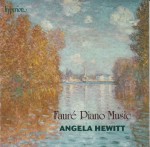 Fauré – Piano Music
Fauré – Piano Music
Angela Hewitt
Hyperion CDA67875
In her informative liner notes, pianist Angela Hewitt writes in her commentary about Gabriel Fauré’s Nocturne No.5 in B-Flat Major, Op.37 that “there is a grace combined with a contained strength behind every note.” This description can also be used to describe Hewitt’s powerhouse performances here.
Thème et variations, Op.73 opens with a march-like statement reminiscent of Hewitt’s Bach performances. The abrupt changes in dynamics from loud to soft are executed perfectly by Hewitt, with heartfelt beauty and an inherent sense of romantic melodic line. Each variation is flowing, clear and spontaneous. After variation 10, Allegro vivo’s dramatic ending, it is Hewitt’s intelligent and emotional interpretation of the more sparse variation 11, Andante molto, moderato espressivo that foreshadows more moving performances of the following two sparkling Valse-caprices and three dreamy Nocturnes. The slightly chromatic nature of the opening melody combined with the darkness of the harmonies of the above-mentioned technically demanding Nocturne No.5 leads to a carefully crafted work of wide-ranging moods. The Ballade pour piano seul, Op.19 is the earliest piece featured. Hewitt’s sense of cadence resolution and manipulation of tempo supports well-defined and tonally colourful melodies and trilling ornamentation.
Hewitt writes that she was first introduced to and learned Fauré’s Ballade as a 15-year-old student. Her decades-long dedication to his work is apparent here. This is not salon music — it is substantial piano repertoire performed unforgettably by a passionate and brilliant pianist.



